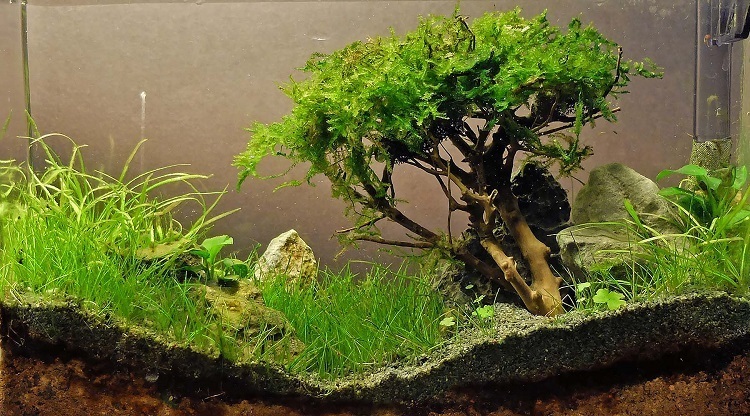Formerly confined by many aquarists to breeding bins where they provided shelter and food for fry, aquatic mosses have benefited from the rise of new trends aquarists that are “shrimp” and aqua-scaping to acquire their letters.
Nobility
These mosses are indeed used in the bins of lovers of crustaceans on the one hand because shrimps love to look for their food, on the other hand for their ease of maintenance that can bring a touch of greenery without necessarily having the conditions necessary for the growth of other more demanding plants. For the aquarium mosses this is essential.
In a few weeks, the moss gave an ancestral character to this decor
In addition, the popular trend of miniature terrestrial landscapes in the aquarium has only served to reinforce this attraction for mosses (as for most small-leaved plants, for a question of scale of course). They can indeed be used for this purpose in various ways. For example fixed on a hardscape of stones or inserted between these stones, they will give the appearance of a vegetation pushing on the side of mountain or tied up a root with the chosen form, they will be the foliage of a tree whose root is the trunk, or finally simply well placed, some species will evoke of themselves a pine or deciduous forest.
At the same time, whereas only the classic Java moss was previously available, the producers have put a lot of new varieties on the market in recent years: Christmas moss, Weeping moss (at the falling port) evoking that of a weeping willow), Flame moss (which on the contrary raises up its wavy strands, etc.
Attach The Mosses
The mosses being epiphytes plants, they will have to be fixed on a support: roots, stones, small pebbles placed on the ground (in particular pieces of plates of slates, or pots in terracotta). Regarding the aquarium moss this is important.
The traditional technique for attaching moss is to attach them to their support with cotton thread or fine fishing line. The “meshes” of this net should be close enough that the moss is well pressed on the support and can thus settle itself after a while.
In some cases, however, this method may be difficult to implement: for example if you want to place a tuft of moss on a large stone, or cover only one side of a piece of wood, twist totally the support in the thread will prove indeed very unsightly since the wire will then be visible. A new technique recently appeared in the aqua community solves this problem: glue. A small touch of Super Glue strong glue deposited on the support makes it possible to fix the plant anywhere and on very precisely defined areas. Contrary to what might be feared, experience has shown that these glues are harmful neither to the inhabitants of the aquarium, nor to the plant so fixed.




